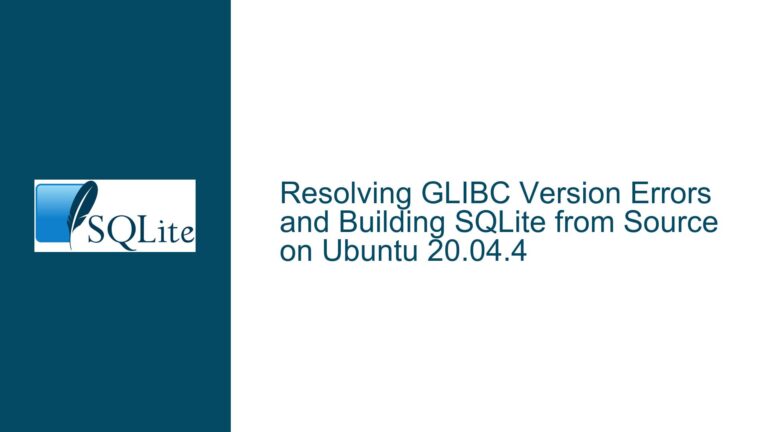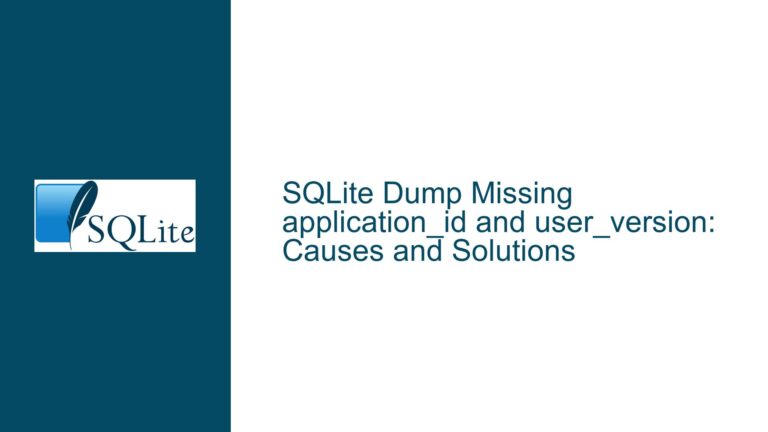SQLite 3.38.0 IA-32 Floating-Point Precision Failures in atof1 Tests
Floating-Point Precision Mismatches in IA-32 Architecture
The core issue revolves around the failure of multiple atof1 test cases in SQLite 3.38.0 when running on IA-32 (32-bit x86) architecture. These tests are designed to validate the accuracy and correctness of SQLite’s floating-point conversion routines, specifically the atof() function, which converts ASCII strings to double-precision floating-point numbers. The failures are characterized by discrepancies between the expected and actual floating-point values, with the tests expecting a result of [1] (indicating success) but receiving [0] (indicating failure). These failures are isolated to the IA-32 architecture, as the same tests pass successfully on x86-64, ARM32, AArch64, and PPC64LE architectures.
The root cause of these failures lies in the differences in floating-point precision handling between IA-32 and other architectures. IA-32 uses the x87 FPU for floating-point operations, which internally operates with 80-bit precision for intermediate calculations. This extended precision can lead to subtle differences in rounding and representation when compared to architectures that use 64-bit precision consistently. These differences become apparent in the atof1 tests, which are highly sensitive to even the smallest deviations in floating-point values.
Architectural Differences in Floating-Point Handling
The IA-32 architecture’s use of the x87 FPU introduces unique challenges for floating-point precision. Unlike modern architectures that rely on SSE or similar instruction sets for floating-point operations, the x87 FPU performs calculations with 80-bit precision internally, even when the final result is stored as a 64-bit double-precision floating-point number. This extended precision can cause discrepancies in rounding behavior, especially when converting between string representations and binary floating-point values.
For example, when converting a string like 1.84896188811229292129657830745515e-05 to a double-precision floating-point number, the x87 FPU might produce a slightly different result compared to architectures that use 64-bit precision throughout the calculation. These differences are magnified in the atof1 tests, which compare the binary representation of the converted floating-point number to an expected value. Even a single-bit difference in the binary representation can cause the test to fail.
Additionally, the x87 FPU’s rounding modes and precision control settings can further exacerbate these discrepancies. By default, the x87 FPU uses a rounding mode that rounds to the nearest representable value, but this behavior can vary depending on the compiler and runtime environment. In some cases, the compiler might optimize floating-point operations in a way that alters the expected results, particularly when intermediate calculations are involved.
Resolving Floating-Point Precision Issues on IA-32
To address the floating-point precision issues on IA-32, several strategies can be employed. The first step is to ensure that the compiler and runtime environment are configured to use consistent floating-point precision and rounding behavior. This can be achieved by setting appropriate compiler flags, such as -msse2 -mfpmath=sse for GCC or Clang, which instruct the compiler to use SSE instructions for floating-point operations instead of the x87 FPU. This approach ensures that all floating-point calculations are performed with 64-bit precision, eliminating the discrepancies caused by the x87 FPU’s extended precision.
If switching to SSE instructions is not feasible, another approach is to explicitly control the precision of the x87 FPU using the FLDCW instruction or equivalent compiler intrinsics. By setting the precision control bits in the x87 FPU control word to 64-bit precision, the FPU can be forced to round intermediate results to 64 bits, reducing the likelihood of precision-related discrepancies. However, this approach requires careful handling, as it can introduce performance overhead and might not be supported by all compilers or runtime environments.
In cases where the precision issues cannot be fully resolved through compiler or runtime settings, it may be necessary to adjust the atof1 tests to account for the inherent differences in floating-point precision between architectures. This could involve relaxing the tolerance thresholds for floating-point comparisons or using architecture-specific reference values for the tests. While this approach is less ideal, it can provide a practical workaround for ensuring that the tests pass on IA-32 without compromising their effectiveness on other architectures.
Finally, it is important to thoroughly test any changes to the floating-point handling logic on all supported architectures to ensure that they do not introduce new issues or regressions. This includes running the atof1 tests on a variety of hardware platforms and compiler configurations to verify that the changes produce consistent and accurate results across the board. By addressing the floating-point precision issues on IA-32 in a systematic and comprehensive manner, it is possible to achieve reliable and predictable behavior in SQLite’s floating-point conversion routines.






